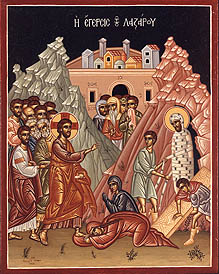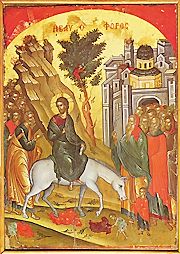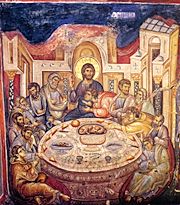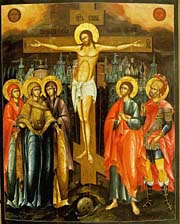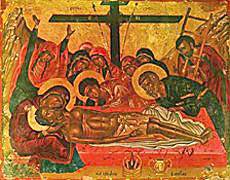Săptămâna Patimilor: Diferență între versiuni
(→Holy Thursday: trimitere legaturi la biblia romaneasca) |
(→Holy Saturday: trafducere) |
||
| Linia 35: | Linia 35: | ||
===Good Friday=== | ===Good Friday=== | ||
'''Great and Holy Friday''' begins with reading of the [[Royal Hours]] leading up to Vespers of Friday afternoon during which the removal of the Body of Christ from the Cross is commemorated. The [[priest]] removes the Body of Christ, the [[Epitaphios]], from the Cross, wraps it in a white cloth and carries it into the [[altar]]. In an evening service, called the Lamentations at the Tomb, the priest carries the Epitaphios, the painted or embroidered cloth representation of Christ, from the altar around the [[church]] before placing it in the Sepulcher, a bier symbolizing the Tomb of Christ. This procession, with the faithful carrying lighted candles, represents Christ's descent into Hades. [[Image:epitaphios.jpg|left|frame|Epitaphios]] | '''Great and Holy Friday''' begins with reading of the [[Royal Hours]] leading up to Vespers of Friday afternoon during which the removal of the Body of Christ from the Cross is commemorated. The [[priest]] removes the Body of Christ, the [[Epitaphios]], from the Cross, wraps it in a white cloth and carries it into the [[altar]]. In an evening service, called the Lamentations at the Tomb, the priest carries the Epitaphios, the painted or embroidered cloth representation of Christ, from the altar around the [[church]] before placing it in the Sepulcher, a bier symbolizing the Tomb of Christ. This procession, with the faithful carrying lighted candles, represents Christ's descent into Hades. [[Image:epitaphios.jpg|left|frame|Epitaphios]] | ||
| − | === | + | ===Sâmbăta Mare=== |
| − | ''' | + | '''Sfânta și Marea Sâmbătă''': Se slujesc Vecernia și Sfânta Liturghie a Sf. Vasile cel Mare, cu citiri din [[Psalmi]] și [[Cântare|cântările]] Învierii care amintesc de coborârea Mântuitorului la Iad, semnificând "Prima Înviere" a lui Adam și biruința asupra morții. |
| + | |||
==Pascha== | ==Pascha== | ||
[[Image:pascha.jpg|right|frame|The Resurrection of Christ]] | [[Image:pascha.jpg|right|frame|The Resurrection of Christ]] | ||
Versiunea de la data 7 februarie 2007 21:15
| Acest articol (sau părți din el) este propus spre traducere din limba engleză!
Dacă doriți să vă asumați acestă traducere (parțial sau integral), anunțați acest lucru pe pagina de discuții a articolului. |
Pentru creștinii ortodocși, Săptămâna Patimilor este săptămâna de la sfârșitul Postului Paștilor, de la Sâmbăta lui Lazăr până la sărbătoarea Paștilor. Se mai numește și Săptămâna Mare.
Cuprins
Istoric
Deși există puține surse care să indice modul în care era celebrată Săptămâna Patimilor în Biserica timpurie, se pare totuși că aceasta este o practică foarte veche. Deja în secolul al IV-lea celebrarea acesteia pare să fi fost deja o practică bine stabilită, structurată într-un mod asemănător celui din zilele noastre. While little is recorded of the development of the celebrations of the Holy Week during the early years of the Church, it apparently had very early origins. By the fourth century the celebration of the week appears well founded and to be similar to our celebrations today. The pilgrim Aetheria to Jerusalem in the latter part of the fourth century described the events of the week after the services of Saturday of Lazarus, "...began the week of the Pasch, which they called here the Great Week", noting the procession commemorating Christ's triumphal entry into Jerusalem on the first day of the week. It is during this week that we remember Christ's Passion and Crucifixion.
The Holy Week
As leave is taken from Great Lent with the celebration of the Saturday of Lazarus, which remembers Christ's raising of Lazarus from the dead and the promise of universal resurrection for all, a week is entered during which the church services remember Christ's last week, the Holy Week, before his crucifixion and resurrection, During this week the Matins Services for the upcoming day is celebrated the evening before, in accordance with the ancient definition that the day is from sunset to sunset.Palm Sunday
The first day of Holy Week begins with Vespers of Saturday evening leading to the celebration of the services of Our Lord's Entry into Jerusalem the next morning, Sunday. In the western world this day is usually called Palm Sunday. As Christ makes his triumphal entry into Jerusalem, his divine kingdom on Earth is proclaimed under the branches of the palm tree.
Holy Monday
The first three days of Holy Week remind us of Christ's last instructions with his disciples. These teachings are remembered in the celebration of the Great Compline, Matins, Hours, and Liturgy during these days.
The Matins services of the evenings of Palm Sunday, and Holy Monday, and Holy Tuesday, anticipating the events of the next day, share a common theme devoted to the Bridegroom Services derived from the Parable of the Ten Virgins that calls for preparedness at the Second Coming, for the "thief comes in the middle of the night." (Matt. 26:1-13)
Holy Wednesday
The Mysterion or Sacrament of Holy Unction is celebrated on Holy Wednesday, commemorating Christ's anointing with myrrh. The service ends with the priest anointing the faithful with Holy Oil. Also, remembered is that on this day Judas betrayed Christ, which led to the tradition from Apostolic times of fasting on Wednesday throughout the year.
Holy Thursday
Holy Thursday begins with the celebration of vespers and the Divine Liturgy of St. Basil with a Reserved Holy Communion in representation of the earthly presence of Christ realized at the Last Supper. In the evening, anticipating the Matins of Friday morning, the Holy Passion service of the reading of the Twelve Gospel is conducted. In these readings Christ's last instructions to his disciples are presented, as well as the prophecy of the drama of the Cross, Christ's prayer, and his new commandment. The twelve readings are:- Ioan 13, 31-18:1
- Ioan 18, 1-29
- Matei 26, 57-75
- Ioan 18,28 - 19, 16
- Matei 27, 3-32
- Marcu 15, 16-32
- Matei 27, 33-54
- Luca 23, 32-49
- Ioan 19, 19-37
- Marcu 15, 43-47
- Ioan 19, 38-42
- Matei 27, 62-66
Good Friday
Great and Holy Friday begins with reading of the Royal Hours leading up to Vespers of Friday afternoon during which the removal of the Body of Christ from the Cross is commemorated. The priest removes the Body of Christ, the Epitaphios, from the Cross, wraps it in a white cloth and carries it into the altar. In an evening service, called the Lamentations at the Tomb, the priest carries the Epitaphios, the painted or embroidered cloth representation of Christ, from the altar around the church before placing it in the Sepulcher, a bier symbolizing the Tomb of Christ. This procession, with the faithful carrying lighted candles, represents Christ's descent into Hades.Sâmbăta Mare
Sfânta și Marea Sâmbătă: Se slujesc Vecernia și Sfânta Liturghie a Sf. Vasile cel Mare, cu citiri din Psalmi și cântările Învierii care amintesc de coborârea Mântuitorului la Iad, semnificând "Prima Înviere" a lui Adam și biruința asupra morții.
Pascha
Easter or Pascha, the Feast of Feasts, celebrations begins just before midnight with the singing of the Odes of Lamentation as the Resurrection Vespers begins with the church in complete darkness. As midnight approaches the priest taking a light from a vigil light within the altar passes the flame to the faithful for their candles while singing "Come ye and receive light from the unwaning life, and, glorify Christ, who arose from the dead." Then, the priest leads the faithful out of the church in procession. After circling the church either one or three times, as the procession nears the entrance door of the church, the priest leads in the singing of the hymn of Resurrection. "Christ has Risen from the dead, by death trampling upon Death, and has bestowed life upon those in the tombs" At this point the priest and faithful enter the well-lighted church for the remaining part of Vespers and the breaking of the fast with the Divine Liturgy. After conclusion of the Divine Liturgy, in many communities, the faithful retire to an agape meal to break the Fast together, and then return home as dawn arrives. Later in the day of Pascha the faithful again gather for prayer with lighted candles in a vespers service, singing the hymn "Christ is Risen from the Dead," and greeting each other joyously "Christ is Risen" and responding with "Truly He is Risen."
